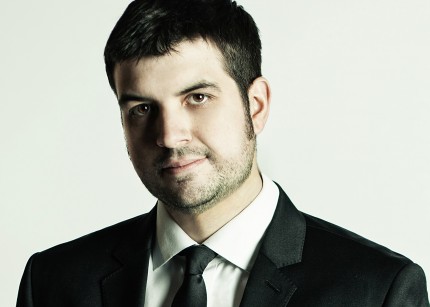Fifth House Ensemble opens tenth season with raucous, rewarding program

On Sunday evening at Constellation Chicago, Fifth House Ensemble kicked off its 10th anniversary season with a bang—as well as a hiss, rattle, pop, and stomp or two.
No stranger to incorporating adventurous acoustic effects in his music, composer Dan Visconti—Fifth House’s director of artistic programming—outdid himself with his quirky Soundings, a commission by Chamber Music America which received its world premiere.
Soundings is billed as a piano trio, but the seven-movement work requires the pianist, flutist (doubling on piccolo), and cellist to all step away from their primary instruments and take up percussive knick-knacks. The “instruments” involved in this sonic menagerie include a beginner’s Harpsicle® harp, a balloon, chopsticks, a rainstick, a tuning peg, what appeared to be an incense stick, and a bag full of ping-pong balls.
Yet Soundings was more a work of musical performance art than absolute music in the sense that the work has to be seen as well as heard. The physical elements of the work are inseparable from its musical premise. As Visconti explains in Soundings’ program notes, its musicians interact by musically and literally “ganging up” against each other.
For example, in the second movement, pianist Katherine Petersen and flautist Melissa Snoza routinely interrupted cellist Herine Coetzee Koschak’s solo—Petersen armed with chopsticks and Snoza with a balloon. As Snoza slowly and squeakily let out the air in the balloon, Petersen playfully drummed Koschak’s fingerboard with chopsticks. The faux-exasperated Koschak would respond with percussive slaps to the fingerboard, which paired with Petersen’s interjections in an impressive interplay.
The effects could be gimmicky at times and certain tricks either caused logistical difficulties or were simply a hard sell. When Soundings’ sheet music became part of the piece—with the trio ripping out the first few pages of the score to conclude the first movement—Koschak ripped her page out with such gusto that she knocked one of her props off her music stand, requiring an awkward pause in the middle of the performance and some quick-thinking improv work. And later Soundings requires the cellist to insert the incense stick inside the flautist’s piccolo, to no discernible acoustic effect. The move seemed engineered solely to attract laughs, like something from Iguedesman and Joo.
But for all its hijinks, the piece’s musical content was undeniably intriguing, beguiling, and smart. Each movement was thematically tight, and for the most part, the percussive toys added to the aural experience. Leading into the Bachian final movement, the ping-pong balls were noisily dumped into the piano, but when sent springing by Petersen’s playing, they became an appealing, off-kilter echo of the bounciness of the fugal lines.
Soundings was billed as the highlight of the evening, and in that respect it did not disappoint. But Fifth House assembled a strong season opener, with the rest of the program proving just as memorable as the main event.
Jennifer Higdon’s Smash and Autumn Music encapsulated the best qualities of the Philadelphia-based composer’s music, namely its vibrancy and idiomatic orchestration. Smash was played with aplomb by Petersen, Snoza, and Koschak, as well as violinist Charlene Kluegel and clarinetist Jennifer Woodrum.
Higdon’s woodwind quintet Autumn Music—a homage to Samuel Barber’s Summer Music for the same configuration—fared less well. The piece bifurcates into two contrasting parts—the first lush and colorful, the second melancholy—and so it was with the interpretation. The first part was played superbly by the ensemble, but the second, more wistful half was given a rather bland, detached reading.
Chicago-based composers Stacy Garrop and Visconti traded pieces for the rest of the program, beginning with Garrop’s engrossing Silver Dagger. Though based on an eponymous Appalachian folk song, the piano trio dutifully avoids kitschy Americana. Dagger could best be described as a fantasy on a theme, with each instrument soaring on virtuosic flights throughout; the energy each musician brought to these flights of fancy made it another highlight of the night.
Silver Dagger proved more memorable than Garrop’s second contribution, Frammenti, which was just that: five short, thematic fragments that probed the surface of an idea, then backed off before it could be fully developed.
Visconti’s other addition to the program was a chamber reduction of his orchestral piece Low Country Haze, which brought the entire ten-person ensemble to the stage. As was constant throughout the night, the group’s ensemble work was committed and seamless. The piece began as a chaotic collection of sounds—clacking of the woodwinds’ keys, pizzicato from the strings—which gradually blossomed into a sweeping melody. Haze ended with a glowing chord from a glass harp played by the group, recalling the tranquil conclusion of blue cathedral by program opener Higdon—a satisfying, ethereal conclusion to a rewarding, raucous night of new music.
Posted in Performances




